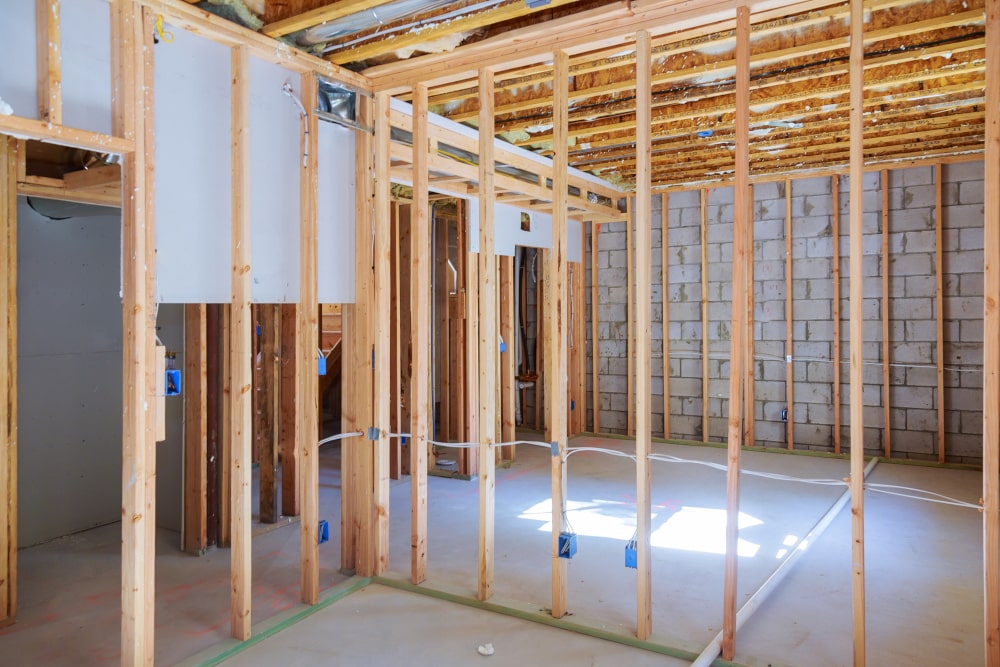
17 Jul How to Frame a Basement
 When it comes to basement renovations, framing is an essential step that can help you set the foundation for a successful project.
When it comes to basement renovations, framing is an essential step that can help you set the foundation for a successful project.
Proper framing not only provides your basement with structural integrity, but also allows for the efficient installation of insulation, electrical wiring, and drywall. Whether you’re planning for a home gym, a home theatre, or even an additional living space, understanding the steps involved in framing your basement correctly is critical in order to ensure an outcome you can be proud of.
How to Frame a Basement Wall
Framing basement walls is a crucial aspect of any basement renovation project. It involves creating a skeleton structure that defines the shape and layout of your space.
Begin by carefully planning the layout of your basement walls. Measure the length and height of each wall, accounting for any obstacles such as pipes, ducts, or obstructions – this will help you determine the amount of lumber and other materials required. Use a chalk line or laser level to mark the locations of the walls on the basement floor, and ensure the lines are straight and accurately reflect your desired dimensions.
Next, it’s time to install a pressure-treated lumber bottom plate along the marked lines. This serves as the base for your wall framing, and helps prevent moisture damage. Secure the bottom plate to the floor using concrete anchors or masonry screws.
Construct your wall frames using standard 2×4 or 2×6 lumber. Cut the boards to the appropriate lengths and assemble them into frames, ensuring they are plumb and square, and use a nail gun or screws to secure the framing members together. Incorporate door and window openings as well – if your basement design includes doors and windows, frame the openings accordingly. Make sure to follow local building codes and use appropriate headers and framing techniques to support these openings.
Finally, with the wall frames built, carefully lift them into position and secure them to the bottom plate and the ceiling joists above. Ensure they are level and plumb before securing them with nails or screws.
Framing Basement Walls
Properly framing basement walls involves more than just constructing the vertical structures – it also includes framing around any obstructions and adding blocking for support. When figuring out how to frame basement walls, keep in mind:
Obstacle Framing: Your basement may have obstacles such as support posts, plumbing pipes, or electrical panels that need to be accommodated in your wall framing. Frame around these obstacles, leaving enough space for access and maintenance.
Blocking and Bridging: Install blocking between wall studs at regular intervals to provide additional support for hanging drywall, securing electrical boxes, and preventing your walls from twisting or bowing over time.
Insulation and Vapour Barrier: Before installing drywall, consider adding insulation and a vapour barrier to your framed walls. This helps improve your basement’s energy efficiency, control its temperature, and reduce moisture issues. Follow local building codes and guidelines for your insulation type and placement.
How Does Framing Fit into a Basement Remodel?
Framing is a critical component of any basement remodel project, as it lays the groundwork for electrical wiring, plumbing, and insulation work, along with finishing touches like drywall and trim changes. Framing also helps create separate rooms, defines your layout, and enhances the overall aesthetics of your basement. Additionally, framing can help strengthen the structural integrity of your space by providing added stability and support.
By framing your basement correctly, you set the stage for a smooth renovation process. Proper framing allows you to create functional spaces that meet your specific needs, whether it’s a home office, a playroom, or an entertainment area. Furthermore, well-executed framing ensures that the finished basement will be durable, safe, and visually appealing.
How Far Should I Frame My Basement Wall?
The distance between your basement walls will depend on various factors, including the layout and purpose of your basement.
In most cases, it is recommended to leave a gap of around ½ inch between your framed basement walls and concrete foundation. This space allows for the installation of insulation, electrical wiring, and proper air circulation.
What Do I Put Under My Bottom Plate When Framing My Basement?
When framing your basement walls, it’s crucial to provide a barrier between the bottom plate and the concrete floor to prevent moisture damage.
One commonly used material is a pressure-treated lumber bottom plate, which is resistant to moisture and decay. Before installing your bottom plate, ensure that your concrete floor is clean and dry. You can also use a foam sill gasket or a moisture barrier to create an additional protective layer between the bottom plate and the concrete.
Where Do You Start When Framing a Basement?
When framing your basement, start by planning your layout and measuring the space accurately. Once you have a clear idea of wall locations, mark them on your basement floor using a chalk line or laser level.
Next, install the bottom plate along the marked lines, securing it to the concrete floor with concrete anchors or masonry screws. After the bottom plate is in place, you can proceed to build the wall frames, incorporating door and window openings as necessary.
Finally, raise and secure your wall frames into position, ensuring they are level and plumb before proceeding with further basement renovations.
When it comes to framing your basement, it’s essential to prioritize safety, accuracy, and compliance with local regulations. With the right techniques and attention to detail, your basement will be well on its way to becoming a comfortable and inviting part of your home.
At Penguin Basements, our team of professionals is here for you to help you frame your basement however you need for your basement renovation project. Reach out to a member of our team today to schedule your consultation with one of our experts, or to get started on your project today!
Christian Saunders, a seasoned marketing professional hailing from Toronto, Ontario, brings over 5 years of valuable experience to our team.
As a key member of our company, Christian plays a pivotal role in crafting compelling content that you encounter on our website and social media platforms. With a keen eye for detail and a passion for effective communication, Christian ensures that our brand's message resonates with our target audience. Beyond his desk, you might spot Christian on our job sites, skillfully capturing multimedia to enhance our visual storytelling.
Don't hesitate to say hello when you see him in action! Christian's dedication and expertise contribute significantly to our mission of delivering exceptional experiences to our valued clients.




